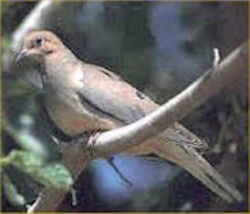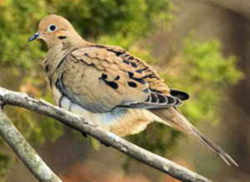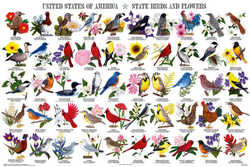Wisconsin State Symbol of Peace
Mourning Dove

(Zenaidura macroura corolinensis linnaus)
Adopted on November 16, 1971.
The mourning dove, (Zenaidura macroura corolinensis linnaus,) was adopted as the state symbol of peace by individuals and organizations concerned with conservation and wildlife, the mourning dove was added to Section 1.10 of the statutes as Wisconsin's official symbol of peace and removed from the statutory definition of game birds by Chapter 129, Laws of 1971. It was adopted on November 16,1971.
A graceful, slender-tailed, small-headed dove that's common across the continent. Mourning Doves perch on telephone wires and forage for seeds on the ground; their flight is fast and bullet straight. Their soft, drawn-out calls sound like laments. When taking off, their wings make a sharp whistling or whinnying. Mourning Doves are the most frequently hunted species in North America.
Wisconsin State Symbol of Peace: Mourning Dove

The reason for concern came from the fact that the mourning dove has long been the most popular game bird in North America (now only legal in 38 states, as well as Canada and Mexico). The debate regarding this issue lasted over a decade and in 1971 the mourning dove was removed from the game bird listing.
They can be found cooing on telephone wires in most neighborhoods in the southern half of the state and in conifer plantations between late March and late September or early October. You'll find them nesting in willows and spruce trees in late April and at your bird feeder in the winter
The mourning dove is well named because its song is certainly suggestive of sadness. It is a sweet sadness though that has a genuine appeal when heard from a distance early on a summer morning. The dove belongs to the pigeon family and looks just like an undersized grayish blue refugee from a pigeon cote.
The sleek flyer is a favorite game bird throughout the Southern states. His flight is so swift and erratic that average hunters are pleased to collect one bird for every four shots. Despite the size, the flesh of the dove is delicious especially when served with wild rice.
Identification Tips
These birds are medium sized, brownish, and with a rounded or pointed, white tipped tail. The males are larger than the females and are slightly brighter colored.
Length: 10.5 inches
Sexes similar
Medium-sized, somewhat slender dove with very thin neck
Black bill
Adult
Pale buff-brown head, neck, breast, and belly
Purple and green iridescence on neck
Small black mark on lower neck
Medium brown back and upper wings, with large black spots on coverts
Long tail is pointed at tip
Dark brown tail with white tips to outer four tail feathers
Juvenile
Dark brown mottled head neck and breast
Scaly neck and upper wings with numerous black spots on coverts and scapulars
Pale belly
Medium length tail is pointed at tip
Food Habits
Mourning doves eat a wide variety of seeds, waste grain, fruit and insects. They prefer seeds that rest on the ground. Occasionally, they eat in trees and bushes when the ground foods have become scarce. 95% of the mourning dove's diet relies on seeds or plant parts. Doves also like to ingest agricultural crops. Those especially coveted are cereal grains such as corn, millet, rye, barley, and oats. On rare occasions, doves can also be seen preying on grasshoppers, ants, beetles, and snails.
Reproduction
Mourning doves are monogamous. Furthermore, some of these pairs stay on as couples thru the winter. After finding a mate, the male imitates the
nest selection site. Nest construction takes over ten hours and covers a span of three to four days. The female generally lay two small, white eggs
in an open nest. Incubation lasts 14 to 15 days. Both the male and the female share incubating and the feeding of the babies.
Mourning doves have the longest breeding season of all North American birds. They can often have three broods in one season.
Behavior
Two much-studied behaviors of mourning doves are their monogamous mating and their widespread migration patterns. Migration originates in the breeding grounds and continues to the southern areas where the doves go to escape the harsh winter months. During migration the birds fly over 1000 of miles through hostile environment to reach their winter resting spot.
Similar species
Long pointed tail is distinctive for adults, while black spotting on coverts and pale color help distinguish it from White-winged and White-tipped Doves. Juvenile is easily confused with Common Ground-Dove and Inca Dove, but is longer necked, shows a pointed tail with more white at edges and lacks cinnamon in primaries.
Wisconsin Law
The law designating the mourning dove as the official Wisconsin state symbol of peace is found in the Wisconsin Statutes, Chapter 1, Section 1.10(3)(a)
1.10 State song, state ballad, state waltz, state dance, and state symbols.
(3) The Wisconsin state symbols are as follows:
(a) The mourning dove (zenaidura macroura corolinensis lin-naus)
is the symbol of peace.
Taxonomic Hierarchy: Mourning Dove
Kingdom: Animalia - animals
Phylum: Chordata - chordates
Subphylum: Vertebrata - vertebrates
Class: Aves - birds
Order: Columbiformes - doves, pigeons
Family: Columbidae - doves, pigeons
Genus: Zenaida Bonaparte, 1838 - zenaida doves
Species: Zenaida macroura (Linnaeus, 1758) - mourning dove, Paloma huilota








